

A Tetrahelix is shown here


After a presentation on some of my research, including on the Tetrahelix, Gerald deJong asked me if I knew that all the Tetrahelix vertex (x, y, z) coordinates could be given rational numbers. This was something that he discovered when he was exploring the Tetrahelix.
I was not aware of this, so I set out to prove it. Here is my proof.
First, recall that a "rational number" is a number that can be written in the form $$ R = \dfrac{A}{B} $$ where "A" and "B" are integers, and B is not equal to zero.
(I also now realize that by scaling the Tetrahelix by the least common denominator, all the vertex coordinates can be written in terms of integers only.)
My proof is by showing the steps used to construct a Tetrahelix, showing that these steps only involve rational vertex coordinates.
So, start with a single Tetrahedron. The Tetrahedron can be orientated and scaled such that the 4 vertices of the Tetrahelix
all have rational number (x, y, z) coordinates. I'll label these vertices, V1, V2, V3, and V4. These are also vectors from the
(arbitrary but fixed) coordinate origin to the vertices. There is no special ordering to the labeling of the vertices.
So I write
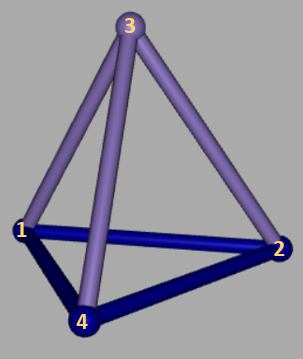
As a concrete example, we could set
Any Tetrahelix built off of the initial Tetrahedron is made by face bonding another Tetrahedron to one of the original Tetrahedron's triangle faces. So we pick one of the Tetrahedron's triangle faces. This has 3 of the Tetrahedron's vertices. I'll use the vertices \( \vec{V}_{1}, \vec{V}_{2}, \vec{V}_{4} \), just to show that we can pick any 3 of the vertices.
Next I calculate the vector from the coordinate origin to the face center of this Tetrahedron face. $$ \vec{V}_{FC} = \dfrac{1}{3} ( \vec{V}_{1} + \vec{V}_{2} + \vec{V}_{4} ) $$
Note that \( \vec{V}_{FC} \) will also have rational coordinates since we only added them together and divide by the integer 3.
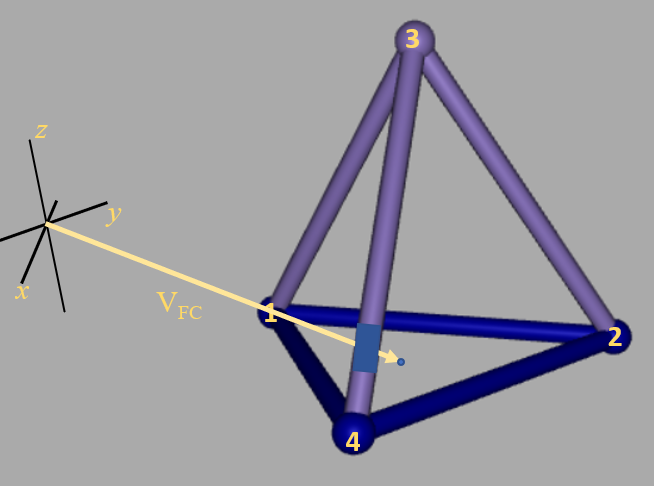
I next make the vector from the vertex not part of the selected Tetrahedron's triangle face, \( \vec{V}_{3} \) in this case, to the face center point \( \vec{V}_{FC} \). I'll label this vector \( \vec{V}_{Dir} \) $$ \vec{V}_{Dir} = \vec{V}_{FC} - \vec{V}_{3} $$
Note that the x, y, z coordinates for \( \vec{V}_{Dir} \) are all rational numbers.
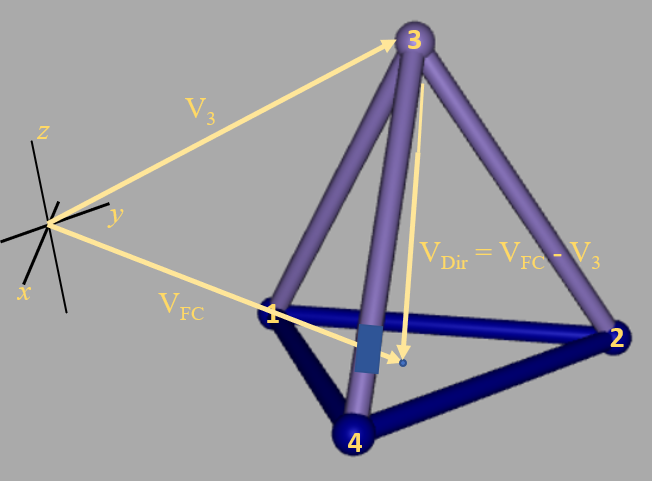
Finally, I add the vector \( \vec{V}_{Dir} \) to the vector \( \vec{V}_{FC} \) to get the coordinate to the new vertex of the Tetrahelix being built. I'll label this new vertex \( \vec{V}_{5} \). $$ \vec{V}_{5} = \vec{V}_{FC} + \vec{V}_{Dir} $$
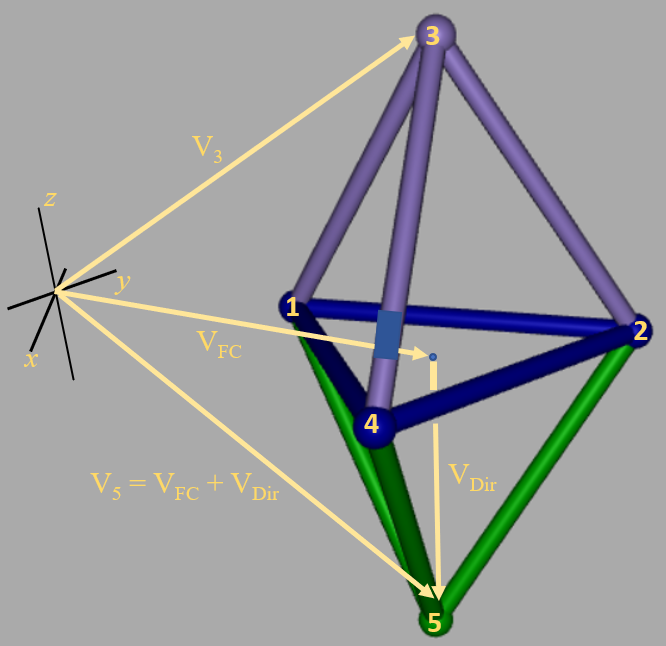
Since all of the operations have resulted in rational numbers only, the new vertex \( \vec{V}_{5} \) has rational number coordinates.
Note that all the vertices of the new Tetrahedron, formed from \( \vec{V}_{1}, \vec{V}_{2}, \vec{V}_{4}, \vec{V}_{5} \), have rational coordinates. We can then select this new Tetrahedron, having rational coordinates, repeat the process above to add a new vertex, that is, face bond another Tetrahedron to it, to continue building the Tetrahelix. Just keep repeating the above process.
With each new Tetrahedron added, only rational coordinates are calculated.
Therefore, the entire Tetrahelix, of any length, will have only rational vertex coordinates.
Since the Octahelix can be created by dividing the edges of the Tetrahelix in half, it is also true that all the vertices of an Octahelix can have rational coordinates.


And since the Cuboctahelix (the VE-helix) can be made by dividing all the edges of the Octahelix in half, all the vertices of the Cuboctahelix can be given rational number (x, y, z) coordinates.


Other results that I now realize based on the above proof:
And by scaling the structure by the least common denominator, all the vertex coordinates can be written in terms of integers only.
I'll describe a little bit about working with Octahedra.
To obtain the Octahedron that is defined by the Tetrahedron, we simply calculate the 6 Tetrahedron's mid-edge points. These are the 6 vertices of the Octahedron. The calculations are: $$ \vec{O}_{1} = ( \vec{V}_{1} + \vec{V}_{2} ) / 2 $$ $$ \vec{O}_{2} = ( \vec{V}_{2} + \vec{V}_{4} ) / 2 $$ $$ \vec{O}_{3} = ( \vec{V}_{1} + \vec{V}_{4} ) / 2 $$ $$ \vec{O}_{4} = ( \vec{V}_{1} + \vec{V}_{3} ) / 2 $$ $$ \vec{O}_{5} = ( \vec{V}_{2} + \vec{V}_{3} ) / 2 $$ $$ \vec{O}_{6} = ( \vec{V}_{3} + \vec{V}_{4} ) / 2 $$ Since all of these calculations result in rational numbers, provided that the Tetrahedron's 4 vertex vectors have rational number coordinates, the Octahedron will have rational number vertex coordinates.
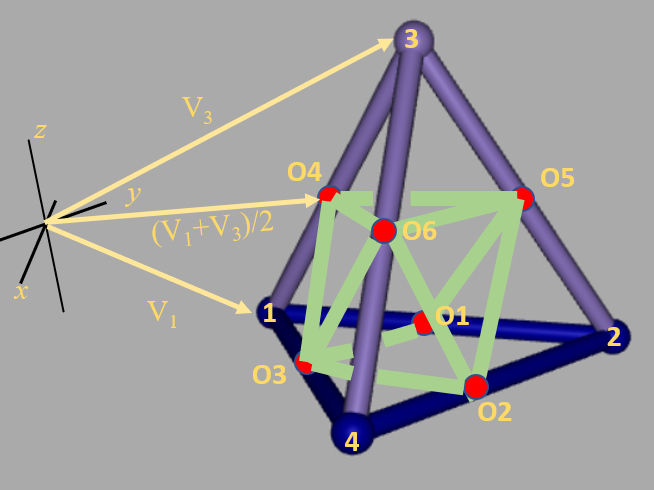
Suppose we have an Octahedron and want to face bond a Tetrahedron. The base 3 vertices of the Tetrahedron will be the 3 vertices of the Octahedron's face to be face bonded to the Tetrahedron. We need to calculate the single additional vertex to the Tetrahedron.

We first calculate the mid-edge point of the Octaedron. In this case, the mid edge point for edge O5 and O6. $$ \vec{V}_{MidEdge} = ( \vec{V}_{5} + \vec{V}_{6} ) / 2 $$

Then we calculate the directional vector from the Octahedron's vertex O2 to this mid-edge point. $$ \vec{V}_{Dir} = \vec{V}_{MidEdge} - \vec{V}_{2} $$
Finally, we add the directional vector to the mid-edge vector. $$ \vec{V}_{1} = \vec{V}_{MidEdge} + \vec{V}_{Dir} $$
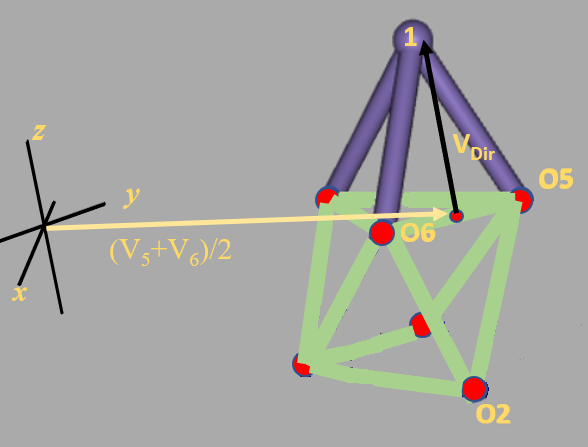
This provides the Tetrahedron's vertex. And since all the math operations involved only rational number manipulations, the new Tetrahedron's vertex coordinates will be rational numbers.
Other vector operations can be developed to face bond Octahedra, VE (Cuboctahedra) as well as any other polyhdra defined by rational subdivision of the Tetrahedron's or Octahedrons' or Cuboctahedron's edges.
For example, we can subdivide the Octahedron's edges by 1/3 lengths to define the truncated Octahedron. The vertices of the truncated Octahedron would then all have rational (x, y, z) coordinates.
We can also scale any of the polyhedra by a rational number to match the edge length of other polyhedra that we might want to face bond to.
Usage Note: My work is copyrighted. You may use my work but you may not include my work, or parts of it, in any for-profit project without my consent.